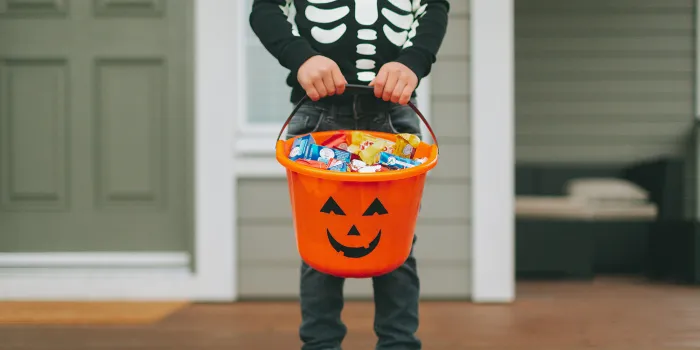Halloween is a fun holiday for children, centered around spooky decorations, imaginative costumes, and copious amounts of candy.
With Halloween treats, as with many things, it’s best to strive for moderation. If you want to enjoy the holiday without your child going candy crazy, try these five tips.
Tip #1: Develop a Candy Plan—Ideally, with Your Child
Do you want to prevent Halloween from being a candy free-for-all? You need to have a plan. It’s even better to involve your child in the process. When they’ve had a say in setting limits around how much candy to collect and eat, your child will be free to have fun within the boundaries.
One way to limit the amount of candy that your child collects is to trick-or-treat with a smaller container. A reasonably sized bag or bucket will fill up faster than a pillowcase, which will give your child a sense of accomplishment without accumulating so many calories.
Set expectations around how many pieces your child can take from each house. For example, encourage taking one piece, even if the host offers more. Getting fewer pieces at each stop also increases the number of houses you can visit, prolonging the trick-or-treat experience.
Other limits you can set are to cap trick-or-treating to a certain number of houses or to a certain time period. Regardless of what it is, when the limit is reached, it’s time to head home.
Finally, agree to revisit your plan to see that it’s working for everyone and make adjustments as necessary.
Tip #2: Choose Non-Candy Treats
Although you can’t control what neighbors hand out, you can guide your child toward making healthier choices. Non-candy options can bring enjoyment, too, especially when you establish a mindset where candy isn’t the focus of Halloween.
You could explain how fruits, vegetables, whole grains, and dairy (that is, nutrient-dense foods) give the body energy to run and jump and play, and how candy and other sugary treats won’t provide the same energy. It’s OK to have candy, within limits.
When you’re having this chat, don’t label candy as bad. Nutritionists agree that using neutral language about foods is best. It avoids children developing unhealthy relationships with food, such as attaching judgment to foods and feeling bad about eating them.
As you trick-or-treat, have your child look for non-candy food options such as snack bags of pretzels, popcorn, baked chips, or trail mix; granola bars; honey packets; and fruit snacks. Non-food options include small toys, stickers, temporary tattoos, glow sticks, snap bracelets, stamps, coloring books, bouncy balls, or pencils.
Tip #3: Eat Before You Trick-or-Treat
If you’ve ever gone to the grocery store hungry and ended up buying more food than you wanted to, you can appreciate the value of your child eating something healthy before going trick-or-treating.
Foods with protein and fiber will keep your child fuller longer. Lean meats, fish, beans, nuts, eggs, and dairy are good sources of protein. Fiber is found in fruits, vegetables, whole grains, and legumes (including lentils, beans, and peas). A quick, filling snack—such as apple slices with peanut butter—can take the edge off of your child’s hunger.
With your child’s appetite satisfied, they may be less inclined to grab fistfuls of candy from the bowl, or to snack on things along the way.
Tip #4: Watch for Food Allergies
For children with food allergies, eating candy or another treat could be life-threatening if it contains an allergen.
The nonprofit group FARE, short for Food Allergy Research & Education, recommends that parents avoid treats (including homemade ones) that don’t have an ingredient label, always carry an epinephrine auto-injector in case of an allergic reaction, enforce a “no eating while trick-or-treating” rule so that treats can be properly scrutinized later, and emphasize the fun of the season rather than the treats.
FARE also created the Teal Pumpkin Project to encourage people to offer non-food treats on Halloween to children, including those with food allergies. Participating households add their address to a searchable map and put out a teal pumpkin or display a sign on Halloween indicating they have non-food treats to give out.
Tip #5: Get Creative with the Extra Candy
If you find that your child has too much candy left over after Halloween, you have a few options for getting rid of it.
Extra candy could be saved as rewards for your child or as treats for an upcoming party.
You could create a trade-in system where your child gives you their extra candy in exchange for something fun, whether it’s a small toy, extra screen time, or a bonus family activity. Or, you could pay cash for their candy.
Dentists are known for their candy buy-back programs. Participating offices collect candy during designated events in exchange for cash or other incentives, with the candy often going to military service members.
Also, many food banks and other charitable groups accept candy donations after Halloween. Search your local area for groups that are collecting.

